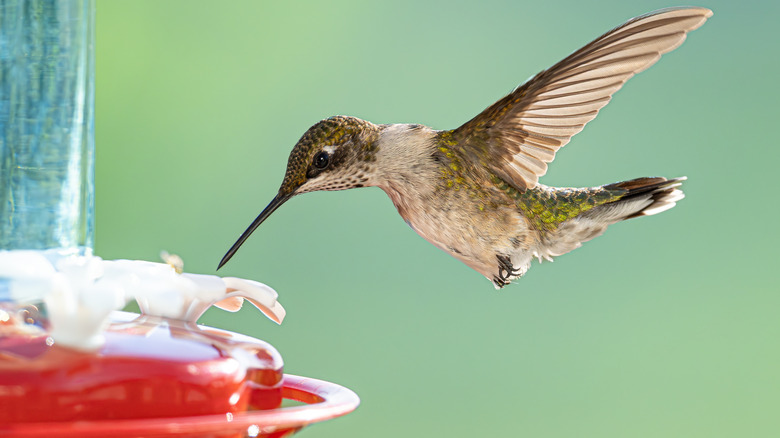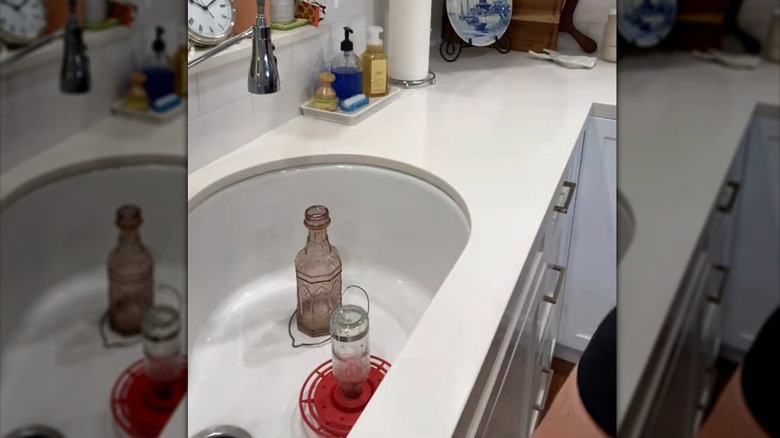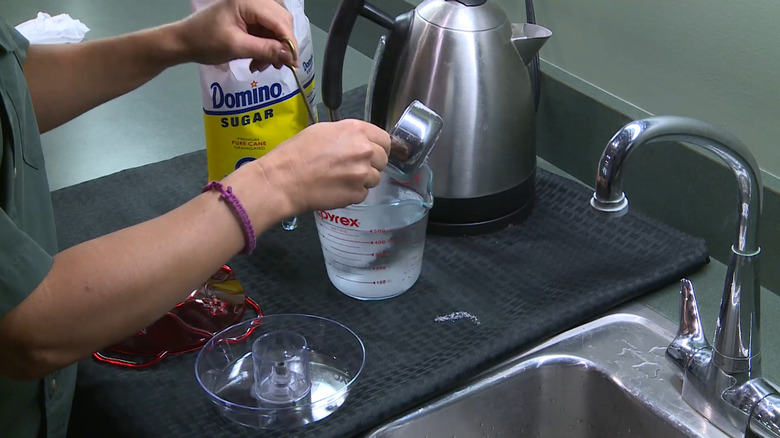Why You Should Be Concerned If The Nectar In Your Hummingbird Feeder Looks Cloudy
When you want to attract hummingbirds to your garden, you often can't go wrong with a hummingbird feeder. However, if you notice your feeder's nectar looks cloudy, it's clear something's wrong. Nectar cloudiness indicates it's spoiled or going bad, often due to bacteria growth or mold, whichcan make your hummers deathly ill. Made with sugar and water, nectar offers an ideal environment for mold and bacteria to fester when exposed to heat. You should immediately remove the spoiled nectar upon noticing it and thoroughly clean the feeder before putting it out again.
Ignore these issues and your little visitors can suffer devastating health effects, including contacting diseases that can cause them to go into respiratory distress, develop a swollen tongue, making eating impossible, or painful lesions in their gastrointestinal tract. All of these can lead to death.
Checking the nectar regularly is crucial, as it can spoil much faster than you might think, turning bad at an accelerated rate when outside temperatures reach over 90 degrees Fahrenheit. Whether you're trying to prevent ants from getting in your hummingbird feeder or thwart dangerous diseases from spoiled nectar, regular cleaning is important — especially if you live in a hot climate or keep your feeders in direct sunlight.
How to clean your hummingbird feeder of mold and bacteria
If you notice mold or suspect bacteria in your hummingbird feeder, clean it immediately. You can use a solution of hot water and 3% hydrogen peroxide to safely clean your hummingbird feeder, scrubbing all of the components. Another option is soaking the feeder in distilled white vinegar for several hours. Dilute it well, using 1 cup of vinegar to 2 cups of water, pouring the solution through the ports to remove all of the spoiled nectar. Rinse well to remove any remaining vinegar traces, then let fully dry before you refill with nectar. Above all, don't use any dish soap, which may leave residue behind. Not only will the soap residue possibly deter hummers away from the feeder, but accidental ingestion could make them sick.
Some nectar holders can go in the dishwasher, which is suitable for more routine cleanings, but if you're dealing with cloudy nectar, the vinegar or hydrogen peroxide (not both!) options are better to completely remove any mold or bacteria buildup.
After you've thoroughly washed your hummingbird feeder, prioritize keeping it safe. Focus on changing out the nectar and cleaning it at least every other day, especially in the hotter times of the year. In cooler temperatures, bi-weekly cleanings may be suitable, as the nectar won't spoil as quickly.
Other reasons your hummingbird water may be cloudy
If you're cleaning your hummingbird feeder regularly, hanging it in a shaded area, and yet still have cloudy nectar, it could be something other than spoiled nectar causing the problem. Using the wrong type of sugar, like brown sugar or honey, can cause clumping, creating a cloudy effect. When making DIY nectar, only use refined white sugar (aka table sugar). Even if you use the correct type of sugar, you will need to mix it well. Stir until the sugar completely dissolves, or the remaining batches of sugar crystals may create a cloudy appearance.
Do you live in an area with hard water? If so, your tap water could be the cause of cloudiness. Hard water contains high levels of calcium and magnesium deposits, which can settle on glass. Try making a new batch with distilled or filtered water to see if that fixes the problem. Finally, a simple explanation may be that something, such as tiny insects or dust, got into the nectar, thereby contaminating it. Even though these instances aren't cause for alarm, hummers may still avoid your nectar station if it's full of discolored nectar, so try to fix the underlying issue as soon as possible. By practicing careful, proper maintenance of your hummingbird feeders, you can encourage these adorable birds to visit your yard for years to come.


